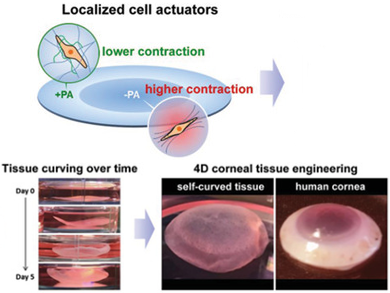Tissue engineering is widely used to construct complex 3D biocompatible structures. Using this technique for the transformation of 3D materials over time, namely, changing their shape, composition, and/or function when subjected to specific external stimuli, extends the technique into the fourth dimension.
Che J. Connon, Newcastle University, UK, and colleagues have developed a biological system which lets cells form a desired shape and structure by using an internal mechanism of stimulus. The team has used a bio-actuator to produce curved collagen gels that could recreate the shape of the human cornea. The cornea is the clear outer layer at the front of the eyeball.
The team prepared a flat circle of a hydrogel containing collagen, encapsulated corneal stromal cells (stem cells) either at low (LDC) or high cell density (HCD) as bio-actuator, and a contraction-inhibiting peptide amphiphile as modulator of the bio-actuator. The stromal cells force the surrounding tissue to move in a predetermined manner over time. The peptide amphiphile decreases the rate of gel contraction within a limited area of the gel. Over the course of five days, a bowl-like curved cornea was formed. Because the process was orchestrated by the cells themselves, the researchers envision them as bio-machines remodeling these structures from the inside.
According to the researchers, their results show that the structural and mechanical properties of self‐curved gels acquired through a 4D engineering method are more similar to those of the native tissue and represent a significant improvement over planar 3D scaffolds. The team sees great potential in cell bio‐actuators for 4D tissue engineering applications.
- 4D Corneal Tissue Engineering: Achieving Time-Dependent Tissue Self-Curvature through Localized Control of Cell Actuators,
Martina Miotto, Ricardo M. Gouveia, Ana M. Ionescu, Francisco Figueiredo, Ian W. Hamley, Che J. Connon,
Adv. Funct. Mater. 2019.
https://doi.org/10.1002/adfm.201807334



